Crptocurrency
ApeCoin DAO Votes to Dissolve Four Non-Essential Working Groups
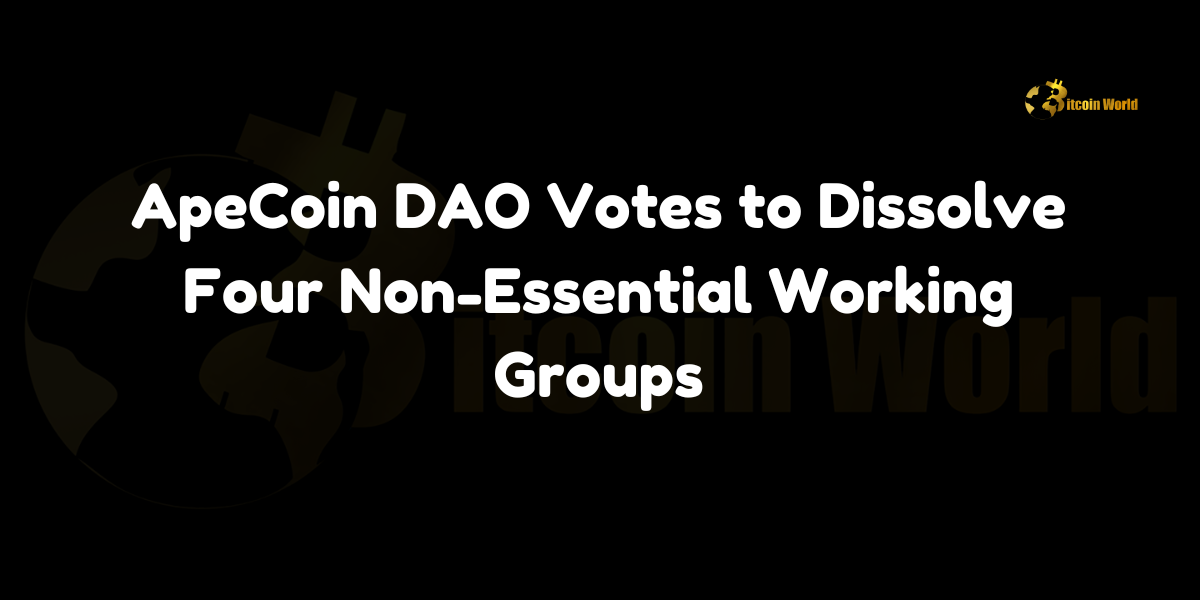
In a move to streamline operations and reduce expenses, ApeCoin DAO has approved a proposal to dissolve four non-essential working groups. With 98.02% support from its community, the decision, as reported by Bitget Exchange, will eliminate groups focused on governance, marketing and communication, the metaverse, and Web3 development. These groups have reportedly cost the DAO around $3 million annually while proving inefficient in task execution, prompting the proposal to prioritize more strategic and essential activities within the organization.
Understanding the ApeCoin DAO and Its Structure
What is ApeCoin DAO?
The ApeCoin DAO governs the ApeCoin ecosystem, which is deeply tied to the Bored Ape Yacht Club (BAYC) and its broader NFT universe. The DAO allows community members to vote on proposals, manage resources, and direct the future of ApeCoin-related initiatives. Through decentralized governance, ApeCoin holders participate in key decisions, ensuring the project remains community-driven.
Role of Working Groups in the DAO
Within the ApeCoin DAO structure, working groups have been created to focus on specific areas, such as governance, marketing, metaverse development, and Web3 innovation. These groups were responsible for driving initiatives within their domains, helping to implement the DAO’s broader vision and goals. However, recent performance evaluations revealed inefficiencies, leading to the proposal to dissolve some of these groups.
Details of the Proposal and Voting Results
Proposal to Dissolve Four Working Groups
The approved proposal specifically targeted four non-essential working groups that had become cost-prohibitive and inefficient in executing their tasks. These groups included:
- Governance Working Group: Responsible for facilitating the governance processes of ApeCoin DAO, including voting and proposal execution.
- Marketing and Communication Working Group: Tasked with managing the DAO’s public relations, branding, and external communications.
- Metaverse Development Working Group: Focused on expanding ApeCoin’s presence and partnerships within metaverse projects.
- Web3 Development Working Group: Charged with advancing Web3 integrations and decentralized applications (dApps) for the ApeCoin ecosystem.
Voting Outcome: Overwhelming Support for Dissolution
The proposal received overwhelming support from the ApeCoin community, with 98.02% of voters in favor of dissolving the four groups. This clear mandate highlights the community’s recognition of the need for more efficient and cost-effective operations.
Financial Implications: Saving $3 Million Annually
One of the primary drivers behind the proposal was the financial burden posed by the working groups. Collectively, these groups were costing the DAO approximately $3 million annually. Dissolving them will allow the DAO to reallocate resources to more impactful and strategic initiatives, enhancing the long-term sustainability of the ecosystem.
Reasons for Inefficiency and Group Dissolution
Underperformance and Task Execution Challenges
The working groups in question were found to be underperforming, struggling to execute their assigned tasks effectively. Delays in project timelines, lack of measurable outcomes, and ineffective use of resources contributed to their dissolution. By eliminating these groups, the DAO aims to streamline operations and focus on areas where tangible progress can be made.
High Costs Relative to Output
The $3 million annual expense was deemed excessive, especially when considering the lack of significant results from these groups. The proposal noted that the funds could be better spent on high-impact projects or improving core areas of the ApeCoin ecosystem that directly benefit the community.
Refocusing on Strategic Priorities
The dissolution of these groups signals a strategic shift within the DAO, prioritizing essential activities that align with its long-term vision. Instead of spreading resources thinly across multiple working groups, the DAO can now concentrate on initiatives that deliver the most value to ApeCoin holders and the broader ecosystem.
Implications for ApeCoin DAO and Its Future Direction
Streamlining Operations
The dissolution of non-essential working groups allows the ApeCoin DAO to streamline operations and reduce bureaucratic overhead. This move is expected to improve decision-making efficiency and speed up the execution of critical initiatives.
Cost Efficiency and Resource Allocation
With the $3 million annual savings, the DAO can reallocate funds to more impactful projects. These could include development in key areas like community engagement, technological innovation, and partnerships that drive real value for the ecosystem.
Focus on Core Projects
By cutting down on ineffective working groups, the DAO can now focus on core projects that are integral to its growth. These may include enhancing ApeCoin’s utility within the Bored Ape Yacht Club ecosystem, developing partnerships in the metaverse, or supporting DeFi and NFT innovations.
Community Empowerment
The overwhelming support for the proposal reflects the community’s desire for a more efficient and results-driven DAO. By empowering the community to make key decisions, the DAO strengthens its decentralized governance model and ensures that members’ interests are at the forefront of its strategic direction.
Challenges and Considerations
Managing the Transition
While the dissolution of these groups is expected to have positive long-term effects, managing the transition will be crucial. Ensuring that ongoing projects are either completed or transitioned smoothly to other groups or structures will be necessary to avoid disruption.
Maintaining Communication and Governance Efficiency
Although the governance and marketing working groups have been dissolved, it remains essential for the DAO to maintain effective communication with its members and ensure transparent governance processes. New mechanisms may need to be implemented to handle these functions without relying on the dissolved groups.
Ensuring Strategic Focus
With the dissolution of the Web3 and metaverse development groups, the DAO must ensure that strategic focus on these emerging technologies is not lost. Finding alternative ways to drive innovation in these areas, possibly through new partnerships or internal teams, will be essential for maintaining momentum in these crucial sectors.
Future Outlook for ApeCoin DAO
Restructuring for Growth
The decision to dissolve non-essential working groups indicates that the ApeCoin DAO is restructuring for growth. By focusing on core areas and improving resource allocation, the DAO is positioning itself for sustained development and long-term success within the NFT, metaverse, and Web3 spaces.
New Opportunities for Community Involvement
As the DAO evolves, there will likely be new opportunities for community members to get involved in shaping its future. Whether through the formation of new working groups, advisory committees, or direct voting on proposals, the ApeCoin DAO continues to empower its members and prioritize decentralized decision-making.
Potential New Initiatives
With additional funds now available, the DAO could launch new initiatives focused on increasing ApeCoin’s utility, improving governance systems, or fostering innovation within the ecosystem. These initiatives could include investments in new decentralized applications (dApps), collaborations with other blockchain projects, or enhancing the ApeCoin marketplace.
Conclusion
The dissolution of four non-essential working groups by ApeCoin DAO represents a significant step toward operational efficiency and cost management. With overwhelming community support, the DAO is set to save $3 million annually, allowing for the reallocation of resources to more impactful projects. By streamlining its structure, ApeCoin DAO can now focus on core initiatives that drive growth, enhance utility, and strengthen its position within the decentralized finance and NFT landscapes.
This move marks an important transition for the DAO, one that prioritizes long-term sustainability, strategic focus, and community empowerment. As the DAO continues to evolve, the decisions made today will shape the future of ApeCoin and its ecosystem for years to come.
To learn more about the innovative startups shaping the future of the crypto industry, explore our latest news article, where we delve into the most promising ventures and their potential to disrupt traditional industries.
Disclaimer: The information provided is not trading advice, Bitcoinworld.co.in holds no liability for any investments made based on the information provided on this page. We strongly recommend independent research and/or consultation with a qualified professional before making any investment decisions.
Crptocurrency
DeBridge Launches DBR Governance Token with Airdrop to Nearly 500,000 Users

In a major development for the cross-chain ecosystem, DeBridge, a prominent cross-chain infrastructure provider, has launched its governance token, DBR, with a significant airdrop to nearly 500,000 early users and community members. According to CoinDesk, the token was built on Solana and has an initial circulation of 1.8 billion tokens out of a total 10 billion maximum supply. The launch marks a pivotal moment for DeBridge as it seeks to decentralize governance and empower its community. Trading for DBR started at $0.03 per token, with the token targeting a fully diluted valuation of $300 million.
Understanding the DBR Governance Token
What is DBR?
DBR is the governance token for the DeBridge ecosystem, designed to allow token holders to participate in governance decisions, such as protocol upgrades, network parameters, and the direction of the platform. By introducing DBR, DeBridge aims to decentralize control over its cross-chain infrastructure and create a more community-driven decision-making process.
Tokenomics of DBR
- Maximum Supply: 10 billion DBR
- Initial Circulation: 1.8 billion DBR (18% of the total supply)
- Airdrop Distribution: Nearly 500,000 early users and community members were selected to receive DBR tokens through an airdrop.
- Initial Price: $0.03 per token
- Fully Diluted Valuation (FDV): $300 million
The distribution of DBR through an airdrop incentivizes early participants and supporters of the DeBridge ecosystem, rewarding them for their contributions and engagement. The airdrop is being conducted in two phases, and recipients must adhere to specific conditions to claim their tokens, including penalties for early full withdrawals.
Phased Airdrop and Withdrawal Penalties
Two-Phase Airdrop Distribution
DeBridge’s airdrop distribution is structured in two phases to ensure that tokens are distributed fairly and to incentivize long-term participation:
- Phase 1: Eligible users can claim a portion of their DBR tokens initially, but only a percentage of the total allocation will be available for immediate withdrawal.
- Phase 2: In the second phase, users can claim the remaining portion of their airdropped DBR tokens. However, penalties apply to users who attempt to withdraw all their tokens early, discouraging short-term speculation and encouraging long-term holding.
The penalty mechanism is designed to promote the stability of the DBR token and prevent rapid selling that could destabilize the token’s market value.
Encouraging Long-Term Engagement
By implementing a phased airdrop with penalties for early withdrawals, DeBridge aims to foster long-term community engagement. This approach encourages token holders to remain active participants in the DeBridge ecosystem and contribute to the governance and growth of the platform over time.
The Role of DBR in DeBridge Governance
Decentralizing Governance
The introduction of the DBR token is a significant step toward decentralizing governance within the DeBridge ecosystem. Token holders will have the power to vote on key governance proposals, including:
- Protocol Upgrades: Proposals to enhance DeBridge’s cross-chain capabilities and infrastructure.
- Network Parameters: Adjustments to transaction fees, security mechanisms, and other core network settings.
- Community Initiatives: Voting on grants, partnerships, and other initiatives that promote the growth of the DeBridge ecosystem.
By giving the community a direct say in the governance process, DeBridge aims to create a more inclusive and decentralized decision-making framework.
Incentivizing Participation
DBR token holders will be incentivized to participate in governance through staking and voting rewards. By actively engaging in the governance process, users can earn additional DBR tokens and contribute to the long-term success of the DeBridge platform. This creates a positive feedback loop where active governance participation leads to increased rewards and influence within the ecosystem.
Trading and Market Impact
Initial Trading and Market Performance
DBR began trading at $0.03 per token, with an initial fully diluted valuation of $300 million. Early trading volumes have been strong, reflecting significant interest in the token from both airdrop recipients and the broader cryptocurrency community.
Potential for Price Volatility
As with many newly launched tokens, DBR is expected to experience price volatility in its early trading days. The phased airdrop and withdrawal penalties are designed to mitigate some of this volatility by discouraging short-term speculation and promoting long-term holding.
Long-Term Growth Prospects
The long-term growth prospects for DBR are closely tied to the success of the DeBridge platform and its cross-chain capabilities. As DeBridge continues to expand its services and partnerships, the utility and demand for DBR are likely to increase. Additionally, as more users participate in governance and staking, the circulating supply of DBR could become more distributed, further stabilizing the token’s price.
The Importance of Cross-Chain Infrastructure
DeBridge’s Role in the Cross-Chain Ecosystem
DeBridge is a cross-chain infrastructure provider that enables seamless interoperability between different blockchain networks. As the cryptocurrency ecosystem becomes more fragmented across multiple chains, cross-chain solutions like DeBridge are essential for ensuring that assets and data can move freely and securely between networks.
By launching a governance token, DeBridge is decentralizing control over its infrastructure and empowering the community to shape the future of cross-chain interoperability. This move aligns with the broader trend in the crypto space toward decentralization and community-driven governance.
Enhancing Cross-Chain Collaboration
The DBR token will play a crucial role in enhancing cross-chain collaboration by incentivizing community members to participate in governance decisions that improve interoperability between blockchain networks. As more projects and users adopt DeBridge’s services, the importance of cross-chain governance will continue to grow, making DBR a key player in the evolution of decentralized finance (DeFi).
Conclusion
The launch of the DBR governance token by DeBridge marks a significant milestone in the platform’s journey toward decentralization and community-driven governance. With an airdrop to nearly 500,000 early users, the DBR token aims to empower the community to take an active role in shaping the future of cross-chain infrastructure. By introducing phased distribution and withdrawal penalties, DeBridge is encouraging long-term engagement and discouraging short-term speculation, ensuring the stability of the DBR token.
As DeBridge continues to expand its cross-chain services and partnerships, the demand for DBR is expected to grow, making it an integral part of the platform’s governance and ecosystem. With its initial trading price of $0.03 per token and a fully diluted valuation of $300 million, DBR has already captured the attention of the crypto market, and its future looks promising as cross-chain solutions become increasingly essential in the decentralized finance landscape.
To learn more about the latest developments in cross-chain infrastructure and governance tokens, explore our latest news article, where we discuss the key trends shaping the future of decentralized finance.
Disclaimer: The information provided is not trading advice, Bitcoinworld.co.in holds no liability for any investments made based on the information provided on this page. We strongly recommend independent research and/or consultation with a qualified professional before making any investment decisions.
Crptocurrency
Interest in TRON-Based Meme Coin Platform Sun Pump Fading Since September

Despite initial excitement around the Sun Pump meme coin platform on the TRON network, interest and activity have been fading since September 2024, according to a report by Onchain Lens on X. Although 90,819 tokens have been deployed on the platform, only a handful of these tokens have gained significant market traction. As of now, only three tokens boast a market cap above $10 million, and just one has surpassed $100 million. Despite efforts by Justin Sun, founder of the TRON network, to promote meme culture within the TRON ecosystem, developer interest appears to be limited, and activity on the platform has slowed down.
Sun Pump: A Brief Overview
What is Sun Pump?
Sun Pump is a meme coin platform built on the TRON network, launched with the goal of fostering the creation and trading of meme coins. The platform was designed to leverage TRON’s fast, low-cost transactions to make meme coin trading more accessible to developers and investors. By encouraging the launch of a wide variety of meme tokens, Justin Sun hoped to replicate the success of meme coins on other networks, such as Dogecoin (DOGE) and Shiba Inu (SHIB), while positioning TRON as a leader in the rapidly growing meme coin space.
Initial Excitement and Token Launches
Upon its launch, Sun Pump generated significant buzz within the TRON community. Developers quickly deployed tens of thousands of meme tokens, hoping to capitalize on the rising popularity of meme coins. By September 2024, the platform had successfully deployed 90,819 tokens, sparking initial optimism about TRON’s potential to dominate the meme coin market.
Slowing Activity and Limited Market Success
Decline in Activity Since September
However, activity on the Sun Pump platform has noticeably slowed since September. Developer interest, which was once robust, has waned in recent months, with fewer new tokens being deployed and less overall trading volume across the platform. While TRON’s infrastructure remains ideal for meme coin creation, the lack of sustained developer engagement suggests that the platform may have struggled to maintain momentum.
Limited Market Success
Out of the 90,819 tokens deployed, only a small fraction has gained notable market success. As of October 2024, only three tokens on the platform have reached a market capitalization of more than $10 million, and just one token has surpassed $100 million. This limited success reflects the challenges meme coins face in standing out in an increasingly saturated market. Even with Justin Sun’s promotional efforts, most meme coins on the platform have failed to capture investor attention or sustain long-term growth.
Challenges Facing Sun Pump and TRON’s Meme Coin Ecosystem
Oversaturation of Meme Coins
One of the key challenges facing Sun Pump is the oversaturation of meme coins within the broader cryptocurrency market. With thousands of meme tokens being created across multiple blockchain networks, it has become increasingly difficult for new tokens to differentiate themselves and gain traction. On TRON, many meme tokens on Sun Pump failed to develop strong communities or compelling narratives, leading to limited adoption and investor interest.
Developer Interest and Innovation
The slowdown in developer activity also points to a potential lack of innovation within the Sun Pump ecosystem. While the platform was designed to encourage creativity, many developers may have struggled to find unique or innovative use cases for meme coins, resulting in a large number of tokens with little real value or utility. This has likely contributed to the stagnation of the platform and reduced overall engagement.
Market Competition from Other Platforms
In addition to internal challenges, Sun Pump faces stiff competition from other meme coin platforms and blockchain networks, particularly Ethereum and Binance Smart Chain (BSC). Both Ethereum and BSC have well-established meme coin ecosystems, with widely recognized tokens such as Shiba Inu (SHIB) and Baby Doge Coin dominating the space. TRON’s late entry into the meme coin market may have hindered its ability to compete effectively, especially when many investors remain focused on more established networks.
Justin Sun’s Efforts to Promote Meme Culture on TRON
Promotion of Meme Coins and the Sun Pump Platform
Justin Sun has long been a vocal advocate for meme culture within the TRON network. Through social media campaigns and partnerships, Sun has attempted to position TRON as a meme-friendly blockchain that offers superior transaction speeds and lower fees compared to rivals like Ethereum. Sun’s efforts included promoting the Sun Pump platform as a space for developers and investors to engage with new meme tokens, hoping to tap into the viral marketing power that meme coins are known for.
Challenges in Sustaining Interest
Despite his promotional efforts, maintaining long-term interest in the Sun Pump platform has proven difficult. The inherent volatility of the meme coin market, combined with an oversupply of tokens, has made it challenging for Sun to keep the community engaged. While some tokens gained early traction, the lack of sustained innovation and unique use cases has led to a drop in activity, particularly as developers shift their focus to other platforms.
What’s Next for Sun Pump and the TRON Ecosystem?
Potential for Future Growth
While current activity on Sun Pump has slowed, there is still potential for the platform to experience a resurgence. If developers can find ways to create more innovative meme coins with unique use cases or applications, it is possible that investor interest could return. Additionally, TRON’s low fees and fast transactions remain attractive features that could give it an edge over competing platforms in the meme coin space.
Need for Community Engagement
One of the keys to reviving interest in Sun Pump is increased community engagement. Successful meme coins often rely on active and passionate communities that drive viral marketing and create organic growth. Without strong community support, even promising tokens are likely to struggle. Fostering a more engaged community around the Sun Pump platform will be essential to its future success.
Expanding Partnerships and Ecosystem Development
For Sun Pump to remain relevant, Justin Sun and the TRON Foundation may need to explore new partnerships and initiatives to attract developers and investors. Collaborations with influencers, DeFi projects, or other blockchain ecosystems could help breathe new life into the platform and increase its visibility within the broader crypto space.
Conclusion
The Sun Pump platform on the TRON network has seen a noticeable decline in activity since September 2024, with only a handful of tokens achieving significant market success. Despite Justin Sun’s efforts to promote meme culture on TRON, the platform faces challenges from oversaturation, a lack of developer interest, and strong competition from other meme coin ecosystems. Moving forward, the platform will need to focus on fostering innovation, engaging the community, and expanding partnerships to regain momentum and compete in the increasingly competitive world of meme coins.
To learn more about the latest trends in meme coins and the broader crypto market, explore our latest news article, where we dive into the key factors driving the future of decentralized finance and digital assets.
Disclaimer: The information provided is not trading advice, Bitcoinworld.co.in holds no liability for any investments made based on the information provided on this page. We strongly recommend independent research and/or consultation with a qualified professional before making any investment decisions.
Crptocurrency
Google Restores Bitcoin and Ethereum Price Charts After Brief Suspension

In a move that sparked widespread discussion within the cryptocurrency community, Google has resumed displaying Bitcoin (BTC) and Ethereum (ETH) price charts in its search results following a brief suspension over the weekend. According to Decrypt, the charts were temporarily removed due to the receipt of inaccurate third-party data, leading to their suspension. The absence of the charts for BTC and ETH led to speculation and frustration among users, some of whom feared the removal might be a form of censorship. However, Google quickly resolved the issue and reinstated the price charts once accurate data was restored.
The Suspension: What Happened?
Temporary Removal of BTC and ETH Charts
Over the weekend, users noticed that price charts for Bitcoin and Ethereum were no longer appearing in Google’s search results. The absence of these two major cryptocurrency charts was surprising, especially since charts for other assets, including Dogecoin (DOGE) and stock prices, remained unaffected. This inconsistency led to immediate speculation within the cryptocurrency community, with some users raising concerns about potential censorship or technical issues.
Google’s Explanation: Inaccurate Third-Party Data
Google later clarified that the suspension of the BTC and ETH price charts was not related to censorship, but rather due to the receipt of inaccurate data from a third-party provider. This data issue prompted Google to temporarily remove the charts to avoid displaying incorrect information. Once the issue was resolved and accurate data was restored, Google reinstated the charts for both cryptocurrencies.
Speculation and Community Reaction
Fears of Censorship
In the absence of an immediate explanation, some members of the cryptocurrency community speculated that the removal of BTC and ETH charts could be part of a censorship effort. Given the growing regulatory scrutiny on cryptocurrencies, users were quick to suspect that the removal could have been influenced by external factors, such as government pressure or regulatory actions.
However, Google’s prompt clarification helped dispel these fears, confirming that the issue was purely technical and related to data accuracy.
Frustration Among Traders and Investors
The temporary suspension caused frustration among traders and investors who rely on Google’s price charts for quick updates on cryptocurrency prices. Many users turn to Google’s search engine for real-time price data, and the absence of the charts for the two largest cryptocurrencies disrupted their ability to track market movements efficiently.
Speculative Discussions in the Crypto Community
The brief removal also fueled speculative discussions on social media platforms like Twitter and Reddit. Users debated whether the suspension was a signal of broader market manipulation or impending regulatory action. While these theories were unfounded, they highlighted the sensitivity of the cryptocurrency community to any disruptions in access to key market data.
Google’s Role in Crypto Market Data
Google’s Influence on Crypto Accessibility
As one of the world’s most widely used search engines, Google plays a significant role in providing users with quick access to cryptocurrency market data. Its integration of price charts for major cryptocurrencies like Bitcoin and Ethereum makes it easy for users to stay informed without needing to visit specialized crypto platforms. This accessibility is crucial for both casual investors and seasoned traders who seek real-time information.
Third-Party Data Providers and Accuracy
Google relies on third-party data providers to supply accurate and up-to-date price information for cryptocurrencies and other financial assets. While this system generally works well, issues like inaccurate data can lead to disruptions, as seen in the case of the BTC and ETH chart suspension. Ensuring that data providers deliver reliable information is essential for maintaining user trust and preventing similar issues in the future.
Broader Implications for Crypto and Data Providers
The Importance of Accurate Market Data
The incident underscores the importance of accurate market data in the cryptocurrency space. In a market known for its volatility, even brief disruptions in access to accurate price information can lead to significant consequences for traders and investors. Inaccurate data can result in poor decision-making, missed opportunities, or even financial losses for those relying on real-time information.
Enhancing Data Reliability
To prevent future occurrences, Google and other platforms that provide cryptocurrency price charts may need to enhance their data reliability by working more closely with data providers. Implementing additional safeguards, such as redundancy systems that cross-check data from multiple sources, could help ensure that users always receive accurate information, even in the event of a technical glitch or data discrepancy.
Reinforcing User Trust
In the wake of this incident, Google’s swift response in addressing the issue and providing an explanation was critical in reinforcing user trust. Clear communication and transparency are essential when disruptions occur, as they help prevent the spread of misinformation and speculation that can damage a platform’s credibility.
Conclusion
The brief suspension of Bitcoin and Ethereum price charts from Google’s search results highlighted the cryptocurrency community’s dependence on reliable, accessible market data. While some users feared the removal was a form of censorship, Google’s explanation—blaming inaccurate third-party data—helped dispel these concerns. The charts were quickly reinstated after the issue was resolved, but the incident serves as a reminder of the importance of data accuracy in the fast-paced world of cryptocurrency trading.
Moving forward, it is likely that both Google and its data providers will work to enhance the reliability of the information they supply to ensure uninterrupted access to accurate cryptocurrency prices. In a market where seconds matter, disruptions like this can lead to frustration and speculation, making data integrity more crucial than ever.
To learn more about how real-time data impacts cryptocurrency markets, explore our latest news article, where we delve into the key trends shaping the future of digital finance.
Disclaimer: The information provided is not trading advice, Bitcoinworld.co.in holds no liability for any investments made based on the information provided on this page. We strongly recommend independent research and/or consultation with a qualified professional before making any investment decisions.
-

 Startup Stories1 year ago
Startup Stories1 year agoWhy Millennials, GenZs Are Riding The Investment Tech Wave In India
-
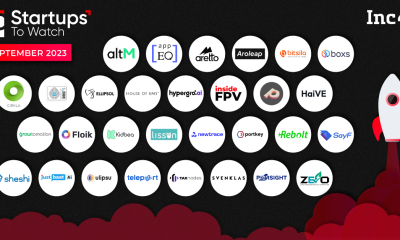
 Startup Stories1 year ago
Startup Stories1 year agoStartups That Caught Our Eyes In September 2023
-

 Startup Stories1 year ago
Startup Stories1 year agoHow Raaho Is Using Tech To Transform India’s Fragmented Commercial Trucking
-

 Startup Stories11 months ago
Startup Stories11 months agoMeet The 10 Indian Startup Gems In The Indian Jewellery Industry’s Crown
-
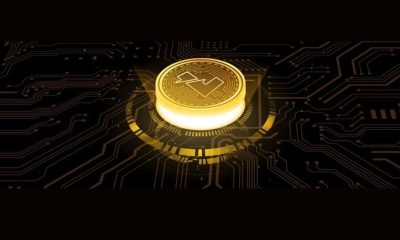
 Crptocurrency8 months ago
Crptocurrency8 months agoLither is Making Crypto Safe, Fun, and Profitable for Everyone!
-
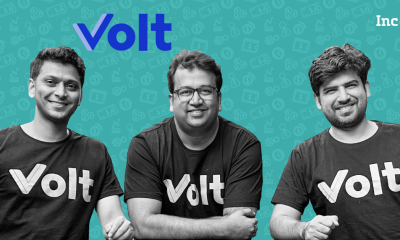
 Startup Stories1 year ago
Startup Stories1 year agoHow Volt Money Is Unlocking The Value Of Mutual Funds With Secured Lending
-

 E-commerce1 year ago
E-commerce1 year agoTop Online Couponing Trends To Watch Out For In 2016
-
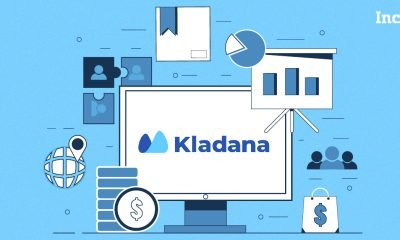
 Startup Stories1 year ago
Startup Stories1 year agoWhy Moscow-Based Kladana Considers Indian SME Sector As The Next Big Market For Cloud Computing




